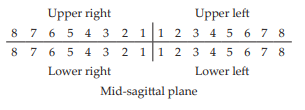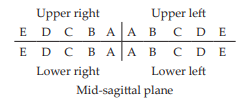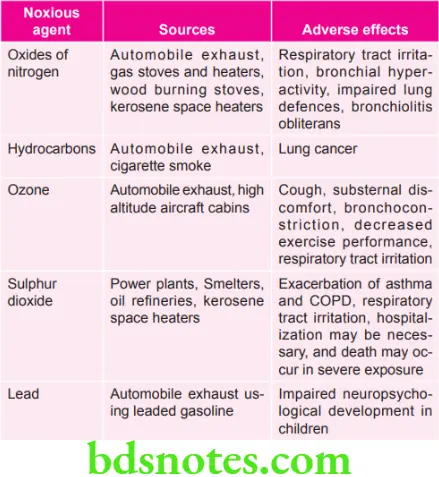Miscellaneous
Question 1. Write in brief on tooth numbering system.
Answer. In clinical practice a short hand system of tooth notation is necessary for recording data.
Tooth Numbering Systems
- Palmer Tooth Numbering System
- It is also known as Zsigmondy–Palmer system or symbolic system or quadrant system or grid system or angular system.
- It is the oldest and one of the popular most system in use during 20th century.
- Hungarian dentist Adolf Zsigmondy develops it in 1861 and later on he modified the system for denoting primary dentition in 1874. Corydon Palmer in 1870 invented the system independently.
- In this system, oral cavity is divided into 4 sections which are known as quadrants.
- Palmer system uses a unique ‘L’ shaped symbol or grid for mentioning in which quadrant a particular specific tooth is present.
- Vertical line of symbol corresponds to patient’s midline and horizontal line corresponds to occlusal plane which separates upper as well as lower arches.
- Counting begins at midline and continue backwards.
- Symbols denoting quadrants in Zsigmondy-Palmer system in both deciduous and permanent teeth are as follows:
- For maxillary right quadrant
- For maxillary left quadrant
- For mandibular right quadrant
- For mandibular left quadrant
Read And Learn More: Public Health Dentistry Question And Answers
Palmer Tooth Numbering System for Permanent Teeth
- Permanent teeth are represented by numerical 1 to 8 in all four quadrants.
- Numbering starts from midline and go backwards.
- Symbols represent the respective quadrants.
- Following is the Zsigmondy-Palmer notation for permanent dentition:

Palmer Tooth Numbering System for Deciduous Teeth
- Deciduous teeth are represented by alphabets, i.e. upper case English letters from A to E are used for representing primary teeth in all four quadrants.
- Numbering starts from midline and move backwards.
- Following is the Zsigmondy palmer notation for deciduous dentition:

Universal Tooth Numbering System
- Universal tooth numbering system was given by Parreidt in year 1882.
- American Dental Association (ADA) officially adapted it in year 1975.
- Universal tooth notation is widely used by dentists in USA.
Universal Numbering System for Permanent Teeth
- In permanent dentition numerical 1–32 denotes the teeth.
- Numbering of tooth starts from posterior most tooth in upper right quadrant, i.e. right maxillary third molar which is denoted as #1 and ends at lower right quadrant, i.e. right mandibular third molar which is denoted as #32.
- Following is the universal tooth notation system for permanent teeth:

Universal Numbering System for Deciduous Teeth
- Deciduous dentition is denoted by upper case english letters for each primary teeth.
- Maxillary teeth are designated from letters A to J, A is right maxillary second molar tooth while mandibular teeth are designated from K to T.
- Following is the universal tooth notation system for deciduous teeth:

FDI Tooth Numbering System
- It is also known as FDI notation system or Two digit system or ISO 3950 notation or International numbering system.
- FDI is denoted as Federation Dentaire Internationale.
- The tooth numbering system is formed by special committee on uniform dental recording. The committee had passed a resolution at FDI General Assembly meeting in 1970 at Bucharest, Romania.
- As per FDI, following criteria should meet FDI toothnotation system, i.e.
- It should be simple to teach and understand.
- It should be easy to pronounce.
- It should be easily printable.
- It should be easily translated into computer output.
- It should be easily adapted to standard charts which are used in general practice.
- In FDI system two digits are used, the first digit denotes the quadrant and second digit denotes the tooth.
FDI Notation for Permanent Dentition
- In this mouth is divided in four quadrants:
- First digit represents the quadrant. Quadrants are 1–4 for permanent dentition.
- Second digit represents the tooth in the particular quadrant. Each of the quadrant in permanent dentition has 8 teeth which are designated with numbers 1–8.
- Two digits should be pronounced separately.
- FDI notation for permanent dentition is:

FDI Notation for Deciduous Dentition
- Four quadrants are designated as 5–8 in clockwise direction.
- First digit represents quadrant from 1 to 5
- Second digit represents tooth in particular quadrant from 1 to 5
- FDI notation for primary dentition is as follows:

Question 2. Write short note on triage.
Answer. Triage consists of rapidly classifying the injured on the basis of severity of their injuries and the likelihood of their survival with prompt medical intervention.
- High priority is granted to victims whose immediate or long-term prognosis can be dramatically affected by simple intensive care. Moribund patients who require a great deal of attention with questionable benefit have lowest priority.
- Triage is the only approach that provides maximum benefit to the greatest number of injured in a major disaster situation.
- Different triage systems have been adopted and are in use in some countries. The most common classification uses internationally accepted four color code system, i.e. red indicates high priority treatment or transfer; yellow signals medium priority; green indicates ambulatory patients and black for dead or moribund patients.
- Triage is carried out at the site of disaster to determine transportation priority and admission in the hospital or treatment center, where patient’s need and priority of medical care is reassessed.
Question 3. Write short note on disaster management.
Answer. It is also known as emergency management.
Disaster management (or emergency management) is the effort of communities or businesses to plan for and coordinate all personnel and materials required to either mitigate the effects of, or recover from, natural or man-made disasters, or acts of terrorism.
Phases of Disaster Management
Emergency management consists of five phases: prevention, mitigation, preparedness, response and recovery.
Prevention
Prevention was recently added to the phases of disaster management. It focuses on preventing the human hazard, primarily from potential natural disasters or terrorist attacks. Preventive measures are taken on both the domestic and international levels, designed to provide permanent protection from disasters. Not all disasters, particularly natural disasters, can be prevented, but the risk of loss of life and injury can be mitigated with good evacuation plans, environmental planning and design standards. In January 2005, 168 Governments adopted a 10-year global plan for natural disaster risk reduction called the Hyogo Framework.
Mitigation
Personal mitigation is a key to national preparedness. Individuals and families train to avoid unnecessary risks. This includes an assessment of possible risks to personal/family health and to personal property, and steps taken to minimize the effects of a disaster, or take procure insurance to protect them against effects of a disaster. Preventive or mitigation measures take different forms for different types of disasters.
Preparedness
Preparedness focuses on preparing equipment and procedures for use when a disaster occurs. Preparedness measures can take many forms including the construction of shelters, implementation of an emergency communication system, installation of warning devices, creation of back-up life-line services (e.g., power, water, sewage), and rehearsing evacuation plans. Planning for all different types of events, and all magnitudes is of utmost importance, so that when a disaster does occur responders know exactly what their assignments are.
Response
The response phase of an emergency may commence with Search and Rescue but in all cases the focus will quickly turn to fulfilling the basic humanitarian needs of the affected population. This assistance may be provided by national or international agencies and organizations. Effective coordination of disaster assistance is often crucial, particularly when many organizations respond and local emergency management agency (LEMA) capacity has been exceeded by the demand or diminished by the disaster itself. On a personal level the response can take the shape either of a shelter in place or an evacuation. In a shelter-in-place scenario, a family would be prepared to fend for themselves in their home for many days without any form of outside support. In an evacuation, a family leaves the area by automobile or other mode of transportation, taking with them the maximum amount of supplies they can carry, possibly including a tent for shelter. If mechanical transportation is not available, evacuation on foot would ideally include carrying at least three days of supplies and rain-tight bedding, a tarpaulin and a bedroll of blankets.
Recovery
The recovery phase starts after the immediate threat to human life has subsided. The immediate goal of the recovery phase is to bring the affected area back to normalcy as quickly as possible. During reconstruction it is recommended to consider the location or construction material of the property. The most extreme home confinement scenarios include war, famine and severe epidemics and may last a year or more. Then recovery will take place inside the home. Planners for these events usually buy bulk foods and appropriate storage and preparation equipment, and eat the food as part of normal life. A simple balanced diet can be constructed from vitamin pills, whole-meal wheat, beans, dried milk, corn, and cooking oil. One should add vegetables, fruits, spices and meats, both prepared and fresh-gardened, when possible.
Question 4. Write short answer on air pollution.
Answer. The term “air pollution” signifies the presence in the ambient (surrounding) atmosphere of substances (e.g., gases, mixtures of gases and particulate matter) generated by the activities of man in concentrations that interfere with human health, safety or comfort, or injurious to vegetation and animals and other environmental media resulting in chemicals entering the food chain or being present in drinking-water and thereby constituting additional source of human exposure.
The direct effect of air pollutants on plants, animals and soil can influence the structure and function of ecosystems, including self regulation ability, thereby affecting the quality of life.
In the past, air pollution meant smoke pollution. Today, air pollution has become more subtle and recognizes no geographical or political boundaries. Air pollution is one of the present-day health problems throughout the world.
Sources of Air Pollution
The main sources of air pollution are:
- Automobiles: Motor vehicles are a major source of air pollution throughout the urban areas. They emit hydrocarbons, carbon monoxide, lead, nitrogen oxides and particulate matter. In strong sunlight, certain of these hydrocarbons and oxides of nitrogen may be converted in the atmosphere into “photochemical” pollutants of oxidizing nature. In addition, diesel engines, when misused or badly adjusted are capable of emitting black smoke and malodorous fumes.
- Industries: Industries emit large amounts of pollutants into the atmosphere. Combustion of fuel to generate heat and power produces smoke, sulphur dioxide, nitrogen oxides and fly ash. Petrochemical industries generate hydrogen fluoride, hydrochloric acid and organic halides. Many industries discharge carbon monoxide, carbon dioxide, ozone, hydrogen sulphide and sulphur dioxide. Industries discharge their wastes from high chimneys at high temperature and high speed.
- Domestic Sources: Domestic combustion of coal, wood or oil is a major source of smoke, dust, sulphur dioxide and nitrogen oxides. The most direct and important source of air pollution affecting the health of many people is tobacco smoke. Even those who do not smoke may inhale the smoke produced by others (“passive smoking”).
- Miscellaneous: These comprise burning refuse, incinerators, pesticide spraying, natural sources (e.g., wind borne dust, fungi, molds, bacteria) and nuclear energy programs. All these contribute to air pollution.
Monitoring of Air Pollution
The best indicators of air pollution are sulphur dioxide smoke and suspended particles. These are monitored on daily basis over several sites. The results are then collected by a central agency.
- Sulphur dioxide: This gas is a major contaminant in many urban and industrial areas. Its concentration is estimated in all air pollution surveys.
- Smoke or soiling index: A known volume of air is filtered through a white filter paper under specified conditions and the stain is measured by photoelectric meter. Smoke concentration is estimated and expressed as micrograms/cubic meter of air as an average level over a period of time.
- Grit and dust measurement: Deposit gauges collect grit, dust and other solids. These are analyzed monthly.
- Coefficient of haze: A factor used, particularly in the USA in assessing the amount of smoke or other aerosol in air.
- Air pollution index: It is an arbitrary index which takes into account one or more pollutants as a measure of the severity of pollution. For example, the following index has been used in USA : 10 times the sulphur dioxide concentration plus twice the carbon monoxide concentration (both in ppm by volume) plus twice the coefficient of haze. It was considered to be a cause for alarm when the value of this index rose from its value of about 12–50 or more.
Effects of Air Pollution
Health Aspects
The health effects of air pollution are both immediate and delayed. The immediate effects are borne by the respiratory system, the resulting state is acute bronchitis. If the air pollution is intense, it may result even in immediate death by suffocation. The delayed effects most commonly linked with air pollution are chronic bronchitis, lung cancer, bronchial asthma, emphysema, and respiratory allergies.
Lead poisons many systems in the body and is particularly dangerous to children developing brain and nervous system. Elevated lead levels in children have been associated with impaired neuropsychological development as measured by loss of IQ, poor school performance and behavioral difficulties.
Table Shows the Major Air Pollutants, their Source and Adverse Effects on Health.

Social and Economic Aspects
These comprise destruction of plant and animal life; corrosion of metals; damage to buildings; cost of cleaning and maintenance and repairs and aesthetic nuisance. Air pollution also reduces visibility in towns. It can soil and damage clothings.
Prevention and Control of Air Pollution
The control of air pollution is ultimately an engineering problem. WHO has recommended the following procedures for the prevention and control of air pollution:
- Containment: That is, prevention of escape of toxic substances into the ambient air. Containment can be achieved by a variety of engineering methods such as enclosure, ventilation and air cleaning. A major contribution in this field is the development of “arresters” for the removal of contaminants.
- Replacement: That is, replacing a technological process causing air pollution, by a new process that does not. Increased use of electricity, solar power generation, natural gas, and central heating in place of coal has greatly helped in smoke reduction. There is a move now to reduce lead in petrol which is a cumulative poison. ln India also deleaded petrol is being used.
- Dilution: Dilution is valid so long as it is within the selfcleaning capacity of the environment. For example, some air pollutants are readily removed by vegetation. The establishment of “green belts” between industrial and residential areas is an attempt at dilution. The capacity for dilution is, however, limited and trouble occurs when the atmosphere is overburdened with pollutants.
- Legislation: Air pollution is controlled in many countries by suitable legislation, e.g., Clean Air Acts. Legislation covers such matters as height of chimneys, powers to local authorities to carry out investigations, research and education concerning air pollution, creation of smokeless zones and enforcement of standard for ambient air quality. To decrease the nuisance of air pollution, the Government of India have enacted “The Air (Prevention and Control of Pollution) Act” in 1981.
- International action: To deal with air pollution on a world-wide scale, the WHO has established an international network of laboratories for the monitoring and study of air pollution. The network consists of two international centers at London and Washington, three centres at Moscow, Nagpur and Tokyo and 20 laboratories in various parts of the world. These centers will issue warnings of air pollution where and when necessary.
Disinfection of Air
In recent years, disinfection of air has received much attention. The methods employed are
- Mechanical Ventilation: This reduces vitiated air and bacterial density.
- Ultraviolet Radiation: This has been found to be effective in special situations such as operation theatres and infectious disease wards. Since direct exposure to ultraviolet rays is a danger to the eyes and skin, the ultraviolet lamps are shaded and located in the upper portion of the rooms near the inlet of air. Ultraviolet rays have proved effective for general use in public assembly and school rooms.
- Chemical Mists: Triethylene glycol vapors have been found to be effective air bactericides, particularly against droplet nuclei and dust.
- Dust Control: Application of oil to floors of hospital wards reduces the bacterial content of the air. Air disinfection is still in the experimental stage.

Leave a Reply